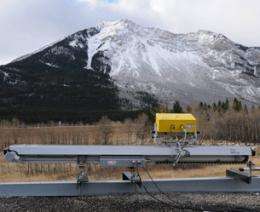New radar helps monitor site of century-old tragedy

(PhysOrg.com) -- A University of Alberta researcher has turned the site of a southern Alberta rockslide tragedy into the proving ground for new equipment meant to avert such a disaster in the future.
In the spring of 1903, the east face of Turtle Mountain, a huge slab of rock estimated to weigh 90 million tons, let go without warning, burying the Crowsnest Pass mining town of Frank.
When the dust cleared, boulders from Turtle Mountain covered the town and three square kilometres of the valley beyond.
Ninety people were killed.
U of A civil engineering professor Derek Martin knows all the science behind rock slides, but he's also adopted a simple belief about mountains. "Nature never likes steep slopes," said Martin. "It likes things flat and that's why, sooner or later, mountains will come down."
Martin and a team from Alberta's Geologic Survey have been monitoring the slightest movements of Turtle Mountain for six years now. But the gauges and satellite GPS monitoring systems set up to measure the growth of cracks and fissures in giant rock faces require people to go up the mountain to set reference points so movement can be detected. Martin says that's risky, time consuming, expensive and doesn't necessarily give researchers a clear overall picture of the mountain's stability.
Instead, Martin says the solution may lie with an Italian-made radar system.
"This device sits at the bottom of the mountain," said Martin of the $250,000 piece of equipment that was set up in mid September. "It sits on a two-metre-long track and moves back and forth scanning the eastern face of Turtle Mountain."
Since 2003, when monitoring of Turtle Mountain began, Martin says some movement on the east face has been detected, albeit just millimetres a year. Martin and engineers with the Alberta's Geologic Survey are hoping the new radar system will provide the same reliable data and replace all the gauges currently hammered into the mountain face. He says this would reduce both the risks and costs for maintaining the gear.
"The weather up there takes its toll on equipment," said Martin. "And you'd be surprised at the damage little varmints can do nibbling on wires."
Martin says he hopes the radar system will have proven its reliability on Turtle Mountain by spring.
"The big unknown for us is how the mountain climate might affect the radar equipment," said Martin. Mountain weather includes extremes in temperature, rapid shifts in humidity, and even the dust kicked up by high winds that could challenge the radar's readings.
Martin would like to try the radar out on a worrisome rock face above a rail line in British Columbia and says there's no reason to think the system couldn't be used to monitor dams and even the earthen walls of tailings ponds used by resource industries.
For the time being, the radar equipment at Turtle Mountain will keep up its slow, back-and-forth tracking of the east face and its five million cubic metres of rock that observers fear will someday come crashing down.
"It's just a matter of time," said Martin. "But time is a very elusive thing when you're dealing with nature."
Provided by University of Alberta (news : web)
















